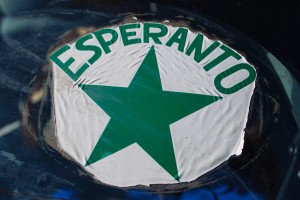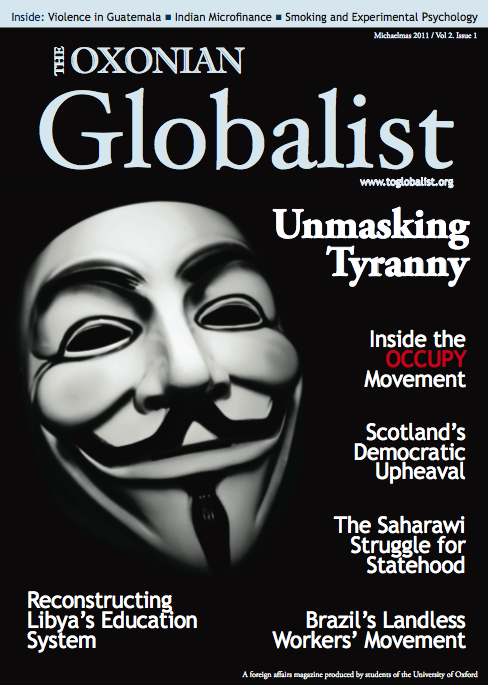
The verda stelo. A green, five-pointed star on a white background is a symbol of mutual recognition among esperantists. From electrobrainpdx via Flickr
The statistic is sobering. More people speak Klingon than Esperanto: not quite the spectacular vision expressed in L L Zamenhof’s 1887 Unua Libro. The Polish linguist, under the pseudonym Doktoro Esperanto (“Doctor Hopeful”), developed his internacia lingva with lofty political aims—it would not have to be anyone’s first language, but it should be everyone’s second. Based largely on Slavic and Romance tongues, Esperanto is lightweight and easy to master; furthermore, its inherent political neutrality should, wrote Zamenhof, foster peace and international understanding in an increasingly fractured political landscape.
Esperanto has enjoyed moderate success. The most comprehensive survey to date estimates two million speakers at “professional proficiency”, though less canonical figures range from ten thousand to an optimistic thirty million. The language even boasts perhaps two thousand native speakers. These are usually individuals born to international households but sometimes children of particularly devoted Esperantists—like Hungarian-American businessman George Soros, son of a famed Esperanto writer.
Speakers of Zamenhof’s brainchild encompass more than just super-enthused linguistics weirdos. In a programme piloted by the University of Manchester, four primary schools in Britain offer instruction in Esperanto in an attempt to improve future language acquisition. The system works: American, Australian, and European studies confirm that students of Esperanto learn a second foreign language—like French or German—with markedly greater success. The International Academy of Sciences in San Marino uses Esperanto as its language of instruction, thereby ensuring diverse international scholarship. Many adult speakers of the language begin their study with an aim to join the Pasporta Servo: a hospitality service wherein Esperantists open their homes to other travelling speakers of the language, often for days or weeks. The Pasporta Servo, report its adherents, furthers Zamenhof’s goal of international communication and support, and its members enjoy world travel without the fear or inconvenience of communication barriers.
The key to Esperanto is its simplicity: Claude Piron, Esperanto author and UN translator, argued that Esperanto “differs from all other languages in that you can always trust your natural tendency to generalize patterns”. Esperanto possesses essentially zero special cases, strange conjugations, or exceptions to its simple rules. Every noun ends in -o—as we want Spanish to be. Simple and consistent modifications (-j, -n) denote noun plurals and the objective case. Speakers recognise adjectives by their -a ending; adverb formation turns that -a into -e (an example: bela means ‘beautiful’ while bele signifies its adverb: ‘beautifully’). Most speakers of Romance or Germanic languages could probably comprehend a substantial portion of a simple Esperanto paragraph with no specific study.
Some opponents of Esperanto, on the other hand, criticise it as malbela (ugly) in its clinical sterility. Conceivably, the simplicity serving as the means of Esperanto’s ease of acquisition leads just as naturally to its supposed disinclination for beauty: it feels too no-nonsense, too purely communicative, to be graceful. Esperanto poetry feels a bit like a Monet landscape replicated in finger-paint—and with only three colours. Nevertheless, Esperanto poets exist: Scottish poet William Auld, who received three nominations for the Nobel Prize in Literature for works written in Esperanto, reported finding the language “especially suited to verse”.
Feminist critics of the language testify to a more specific concern: its adherence to male-dominated power structures. Because Esperanto possesses no grammatical gender, male and female forms cannot be differentiated in usual ways. Masculine nouns—like patro for ‘father’, viro for ‘man’, princo for ‘prince’—do not have equivalent and symmetrical female counterparts; patrino, virino, and princino, respectively, form ‘mother’, ‘woman’, and ‘princess’. Critics decry this system as furthering the inherently flawed worldview that motherhood is a subset of fatherhood, womanliness a mere shadow of the stronger and more essential manliness. Reformist scholars have proposed updates to the structure of Esperanto, but none have achieved mainstream success.
Broadly, cultural quirks and linguistic idiosyncrasies supply each other. Every language has its own examples: when members of the Pirahã tribe in Brazil count, they name one, two, many; perhaps consequently, Pirahã can accurately reproduce counts of two or three items but not four or more. Northern Australian aboriginal languages tend not to use relative directional terms like “left” or “right”: come and sit southwest of me, they might command. If asked to put a sequence of photos in sequential order, native speakers of these languages don’t do it the English-speaking way—left to right—or the Arabic-speaking way—right to left—but rather orient the pictures from east to west, no matter where they are or which direction they face (understandably, it took perplexed English-speaking anthropologists many trials to resolve the apparent discrepancy). The word for “key” is masculine in German and feminine in Spanish; when asked (in English and therefore without grammatical gender) to describe general features of keys, Germans name them “hard”, “heavy”, and “jagged”, while Spanish speakers emphasise keys’ feminine qualities: “intricate”, “lovely”, “tiny”. The results were predictably reversed for a word like “bridge”, which takes the German feminine form and the Spanish masculine. Esperanto lacks these curious anecdotes: it is baldly European and straightforward. It sacrifices the nuances that can only come from hundreds of years’ evolution for the sake of communicative simplicity.
Clearly, linguistic success proves difficult, if not impossible, to measure. A language’s use (or lack thereof) could signify triumph or failure until one considers that Latin is dead while Simlish (the gibberish spoken by avatars from The Sims games, accompanied by miniature cartoon thought bubbles) lives and evolves with each new release. Esperanto has the necessaries: people use it to communicate with families, friends, and strangers. It boasts credible poetry and prose. The Esperanto Wikipedia has the 27th highest count of articles—more than in Serbian, Bulgarian, or Hindi. On the 150th anniversary of Zamenhof’s birth, Google’s now-famous celebratory Doodles featured an Esperanto flag, to the overexcited cheers of some and the understandable confusion of most. The language has visibility and—having been recognised by UNESCO in 1954—legitimacy. If the historically-minded insist upon measuring Esperanto by its creator’s original goal—universality in communication, like-mindedness in understanding—then they must denounce the language a failure due to its tiny percentage of speakers. But that disheartening fact somehow fails to stop thousands if not millions of disparate and devoted Esperantists from celebrating Zamenhof Day, from attending the annual World Conference of Esperanto, or from pestering friends and family with incessant linguistics chatter. Perhaps Zamenhof wouldn’t be too disappointed in the fate of his creation, after all.



